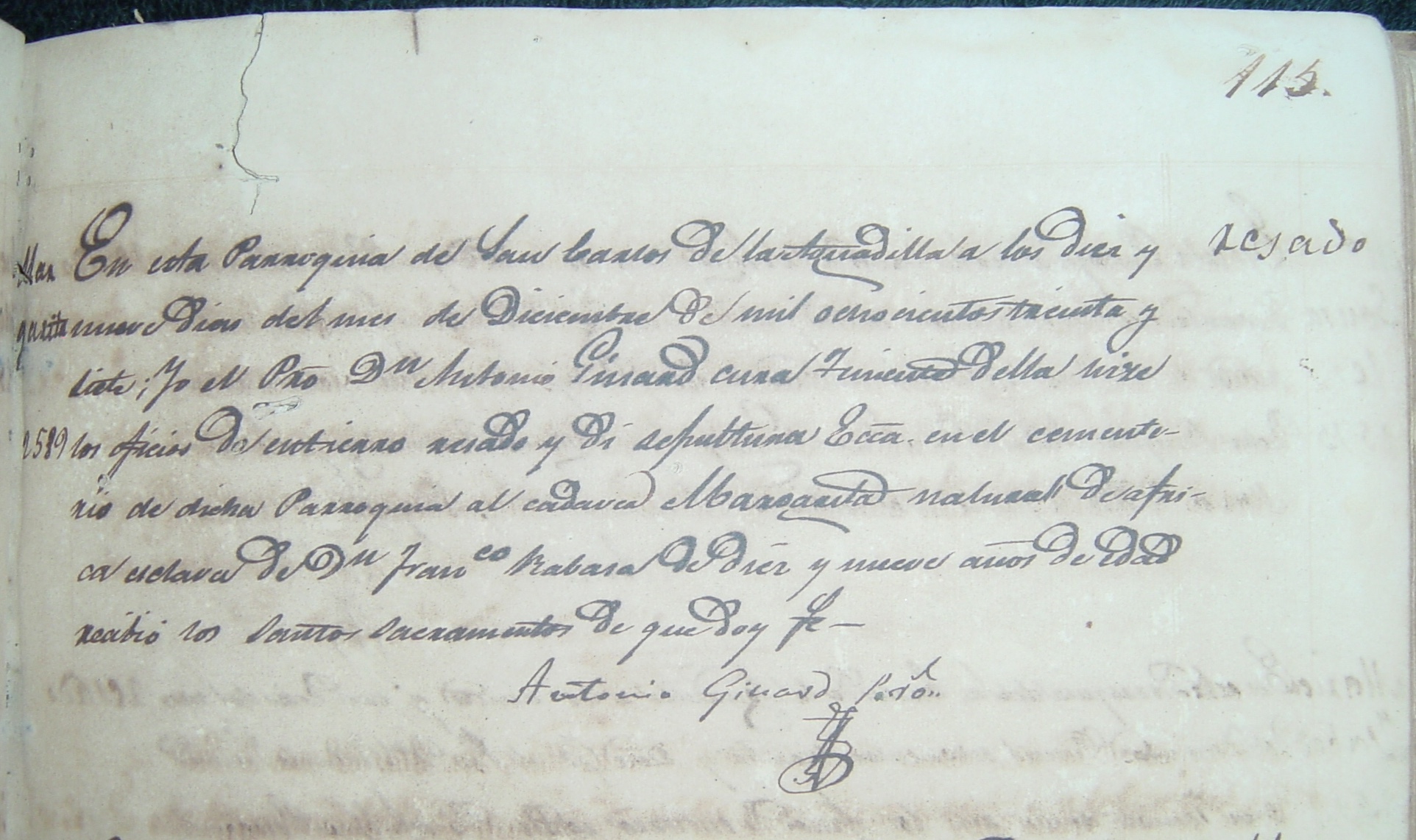This post, based on transcriptions of a notary document from Aguadilla, speaks the names of several enslaved ancestors held in Aguadilla by Pedro Pellot. Pellot, one of four Peugeot siblings from Fuenterrabia (Hondarribia in Basque), Gipuzkoa, in the Basque Country of the Atlantic Pyrenees in Spain. The siblings arrived in Puerto Rico in 1804.[1]
By 1810, Pellot became a partner in the company of d. Pedro Abadia (Pedro Manuel Abadia Valencia ca 1727-1828) and d. Martin Lorenzo de Acevedo y Hernandez (1749-1828; also my 4th GGF). Pellot first administered, then purchased Abadia’s hacienda in Barrio Aceituna and expanded it, acquiring some 105 souls to work the coffee plantation by 1847.
While Hacienda Yruena, was among the three largest haciendas in Aceitunas, Pellot held the largest number of enslaved people in the municipality. He sold the property to its administrator, Juan Labadie Larre. The big house was rebuilt in 1903, and today is known as Hacienda Labadie. [2]
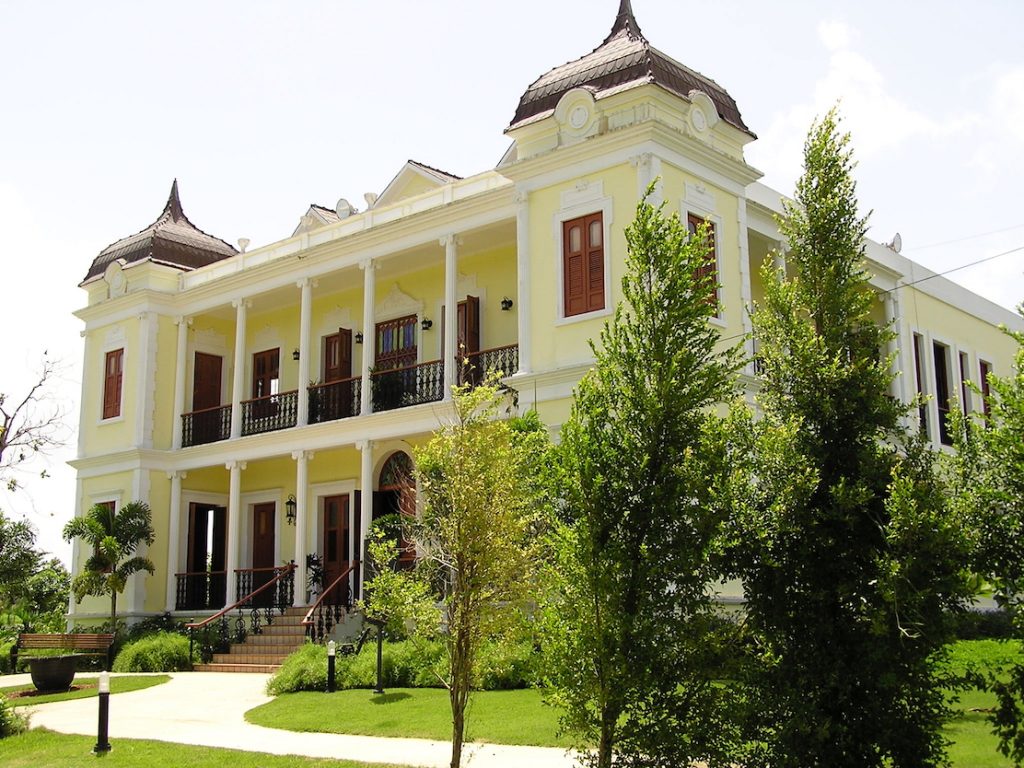
Margarita
At the end of December 1822, d. Pedro Pellot purchased Margarita (bca. 1806), a young 16 year old woman, born in Guinea from Da. Maria Lucia Domenech Arze (1792-1832). [3] Maria Lucia also came from a family of enslavers, as at least one enslaved person held by her father d. Jose Domenech, appears in the first Libro de Defunciones for Aguadilla.[4]
Maria Lucia Domenech was the wife of d. Francisco Rabasa Dalmaso, a Catalan who settled in Aguadilla and whom she married three years earlier. Rabasa was also involved in buying and selling humans in the 1820s. Domenech made the sale on the basis of her rights under marriage to conduct business, and eventually, Margarita became the property of Pedro Pellot.
We come to know of Margarita’s life in Puerto Rico as part of a series of transactions. How accurate was the recording of her age? How many Margaritas were there on the Pellot plantation? This is an issue one faces when researching enslaved ancestors, as the focus on familial details is reserved for the enslaver, while personal details are used to maintain the status of the enslaved as property, and later in the century, after 1868, they became citizens incrementally.
Searching for Margarita
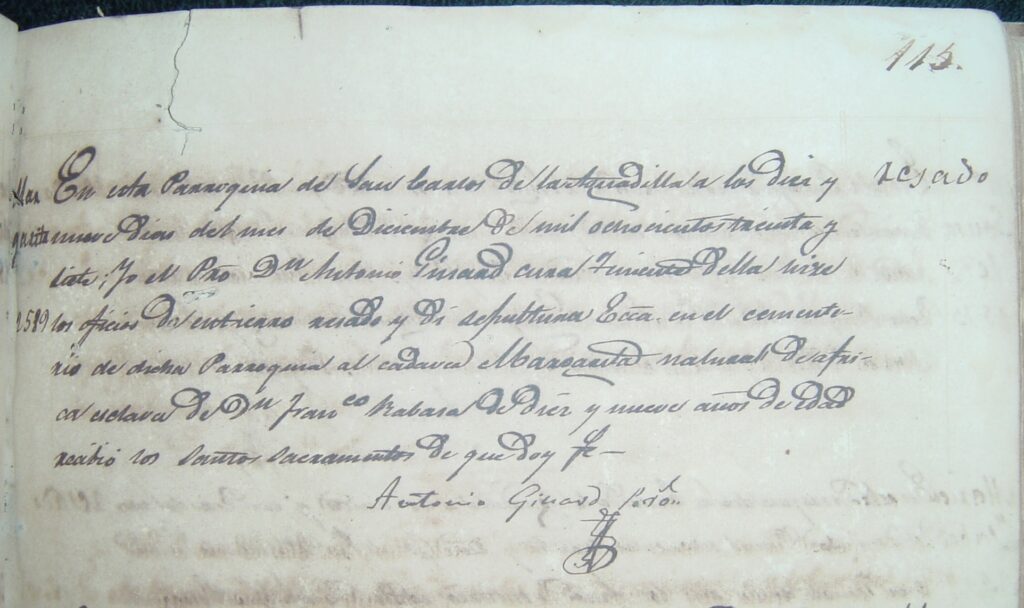
In Libro 6, F115 #2589 of entierros for San Carlos de la Aguadilla is a record for another Margarita, born about 1818. On 19 December 1837, she was buried at the age of 19 years. According to the entry she was also enslaved by d. Francisco Rabasa. As Margarita (b.ca 1806) from the 1822 sale does not appear among the cedulas of 1868-70 in Caja 4 of the Registro de Esclavos, she either managed to buy her freedom, was sold away, or died. The difference in age, together with the children born after 1837 suggests that Margarita survived, unless the children belonged to a different Margarita.
Other persons enslaved by Rabasa were born in Africa, such as Maria who died in 1828 (without noting her age or any other details), and Juana Rita 28, who died in 1843. The 1826 Relacion de Esclavos de Aguadilla has a list of enslaved people held by d. Francisco Rabasa. At the top of the second column appears yet another Margarita, age 11 bca. 1815.
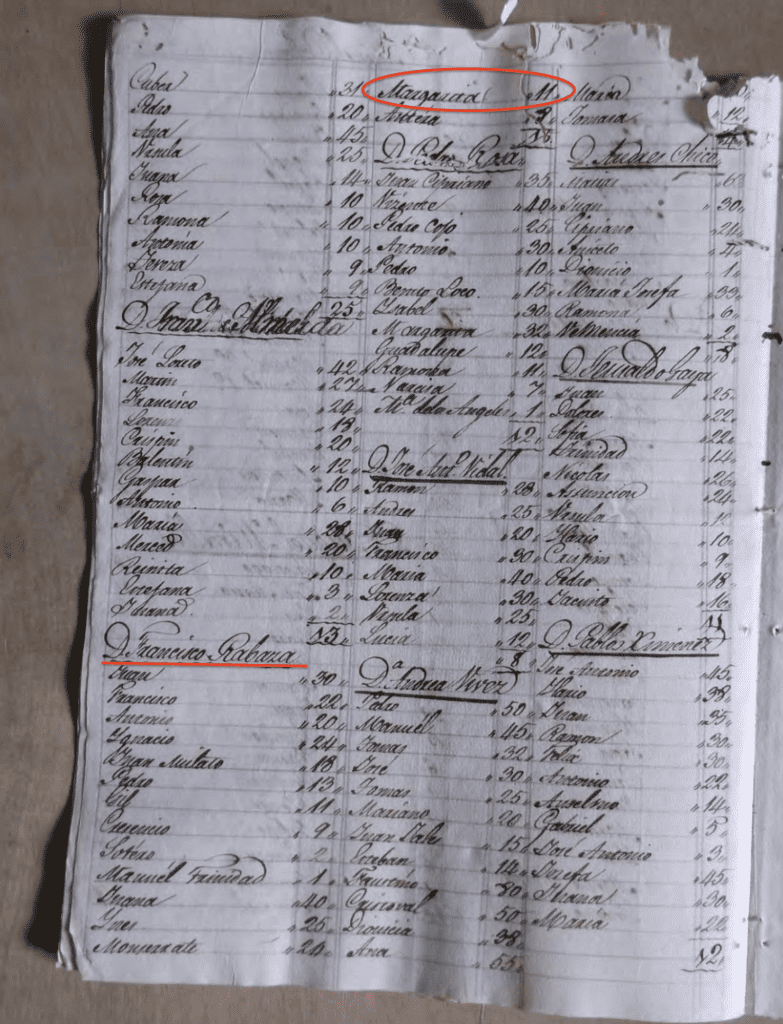
Another Set of Sales: Four Boys, Aguadilla, 1822
Four boys trade hands in Aguadilla in March 1822. While we have the record for Pellot’s purchase, there are another set of entries that offer the outlines of trafficking in small numbers of those enslaved.
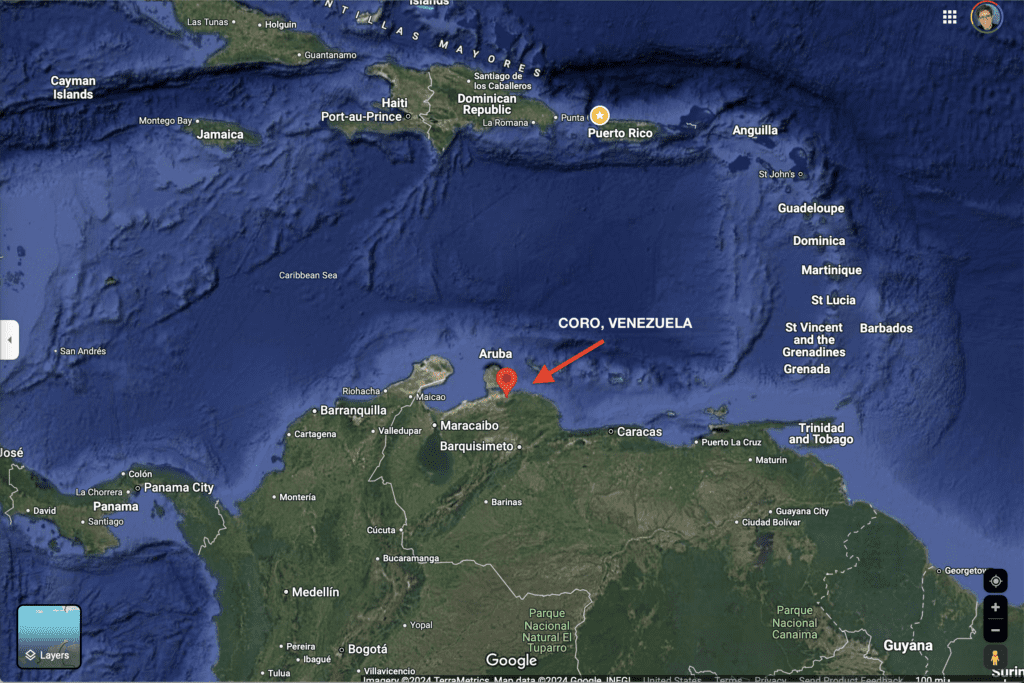
In March 1822, Pellot purchased four enslaved children born in Coro, Venezuela from D. Jose Antonio Vidal and D. Carlos Espinet. The boys were between the ages of 10 and 14, and worked as house servants. A host of questions come up– where were their mother or parents? Were they separated earlier? When did they gain their freedom? Did they ever and when? What surname did they take on? Over how many continents did their origin reach? They are:
José Eduviges de 14 años, b, 1808
José Perfecto de 10 años, b.1812
Francisco de la Yuga de 11 años b.1811
José Manuel de 10 años b. 1812 [4]
As the century wore on, there was a growing preference for purchasing children, with the expectation of a longer term of labor. [5] According to the entry, they were first sold as a group for 725 pesos by Nicolas Franson (b. Genoa, Italy) to Jose Antonio Vidal and Carlos Espinet. The price that Pellot paid is not recorded in their resale on the 23 March 1822. [6] Franson was a captain, specifically of the ship Monserrate, ‘goleta espanola’, a two masted schooner, that suggests he was also capable of transporting the enslaved. I am left with questions and the hope of finding something more.
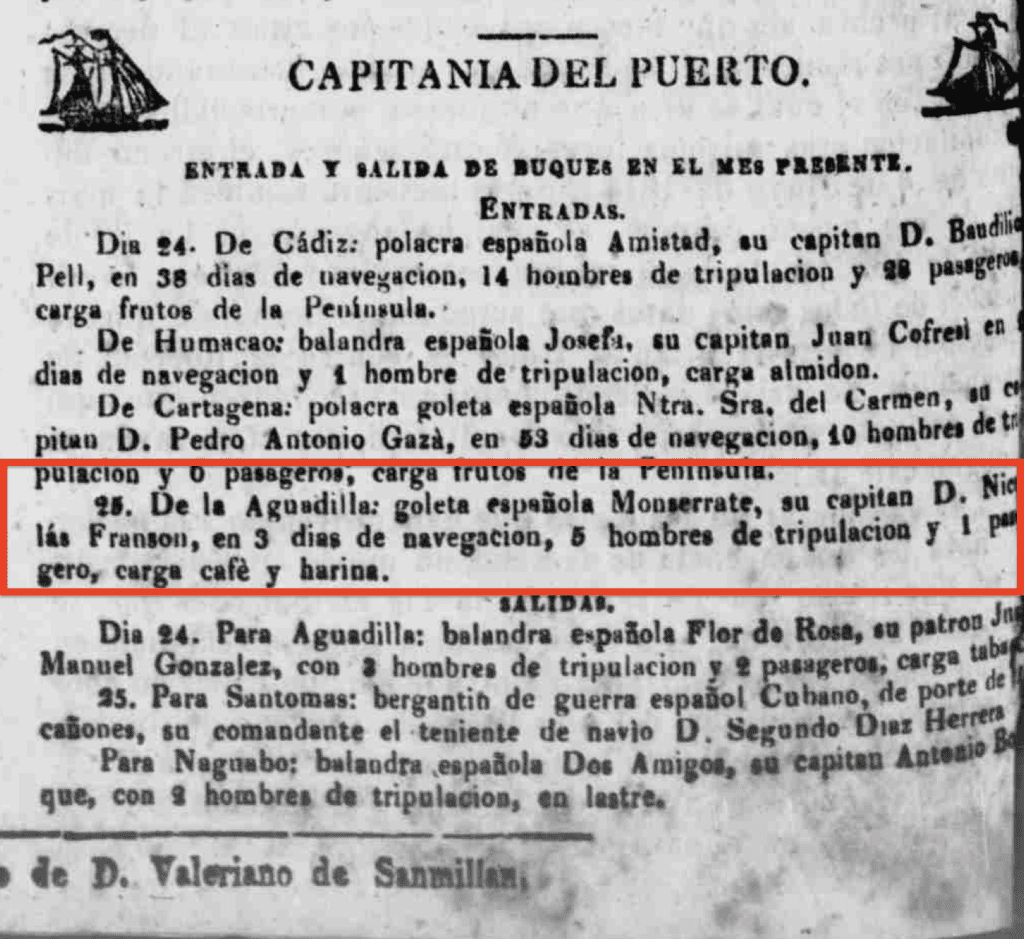
The witnesses to the sale were D.Francisco Rabasa, D.Juan Bautista Doumeng and D.Jose Joaquín Miranda, all local plantation owners and enslavers. These documents show the small scale of human trafficking among married couples, emigres who shared French or Basque origins and local partnerships. By 1850, more formal businesses were involved.
Trafficking from Coro to Aguadilla, 1822
Here are all of the enslaved persons from Coro who were trafficked in Aguadilla for the year of 1822
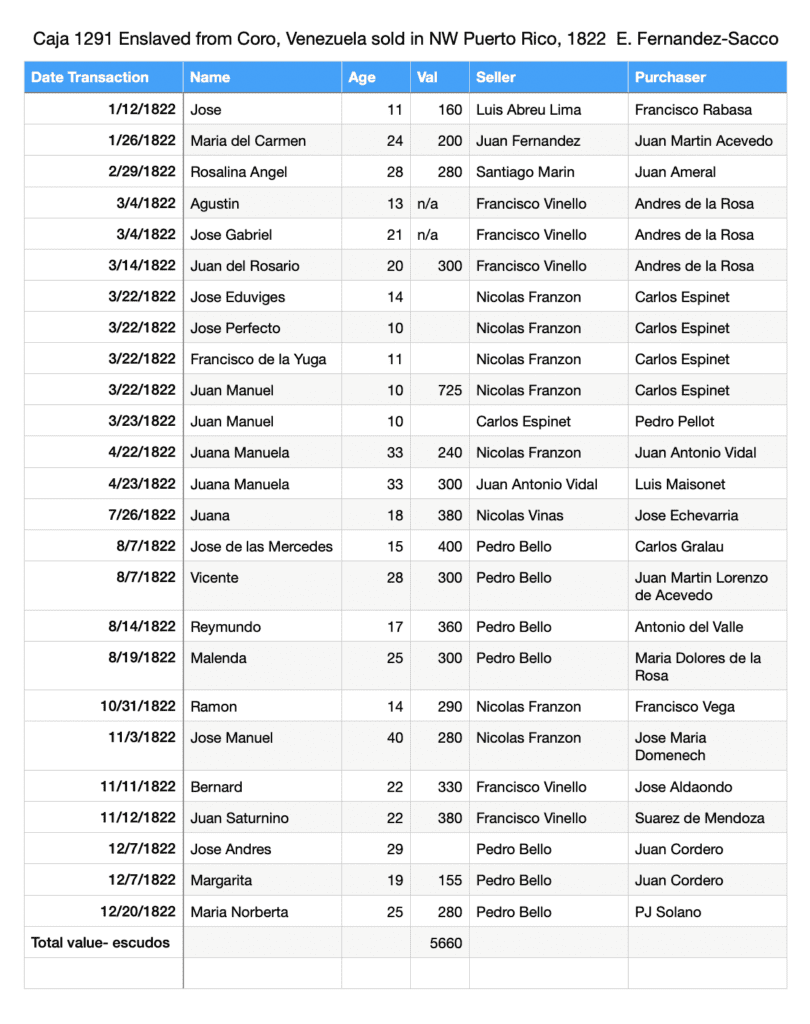
References
[1] Ellen Fernandez-Sacco, “Reconstructing District 3’s Missing 1872 Registro Central de Esclavos for Northwest Puerto Rico.” [Part 1 of 4] Hereditas 2019, 73. Antonio Nieves Méndez, Historia de un pueblo: Moca 1772-2000. Ediciones Aymaco, lulu.com 2008, 247.
[2] Nieves Mendez, Historia de un pueblo: Moca 1772-2000., 247.
[3] Caja 1291 En Aguadilla 3-22-1822 fol 128 ante mi,el escribano Real y público y testigos que se nominaran compareció D.Nicolás Franson de este vecindario y dijo que da en venta Real a D.José Antonio Vidal y a Carlos Espinet de la propia vecindad 4 esclavos de su propiedad nombrados José Eduviges de 14 años, José Perfecto de 10 años, Francisco de la Yuga 11 años y José Manuel de 10 años naturales del Coro y se los vende por la suma de 725 pesos. Testigos y vecinos lo fueron D.Francisco Rabasa, D.Juan Bautista Doumeng y D.José Joaquín Miranda. Instituto de Cultura Puertorriquena, AGPR, Fondo de Protocolo Notariales, Caja 1291, Serie- Aguadilla, Pueblo- Aguadilla, Escribano Jesualdo Gaya 1821-1822. Transcrito por Carlos Encarnacion Navarro.
[4] Caja 1291 f370v-372, 31 Dec 1822; f131v – 132v, 23 March 1822
[5] According to Perez Vega, when the port of Ponce was opened in 1812, the port facilitated the direct arrival of free and enslaved people. For more on the traffic in children see Ivette Perez Vega’s “El trafico de ninos esclavos en el sur de PR, Ponce (1815-1830).” https://publications.iai.spk-berlin.de/servlets/MCRFileNodeServlet/Document_derivate_00001299/BIA_103_025_049.pdf
[6] Caja 1291, En Aguadilla 3-23-1822 fol.131-v a 132-v ante mi, escribano Real y público y testigos que se nominaran comparecieron D. José Antonio Vidal y D. Carlos Espinet de este vecindario y dijeron que daban en venta Real a D.Pedro Pellot del mismo vecindario 4 siervos esclavos nombrados José Eduviges de 14 años, José Perfecto de 10 años, Francisco de la Yuga de 11 años y José Manuel de 10 años todos naturales del coro. Testigos y vecinos lo fueron D.Francisco Rabasa, D.Juan Bautista Doumeng y D.Jose Joaquín Miranda.
Citation: Ellen Fernandez-Sacco, “Remembering enslaved ancestors purchased by Pedro Pellot, Aguadilla, 1822.” Latino Genealogy and Beyond, 9 Nov 2024.

